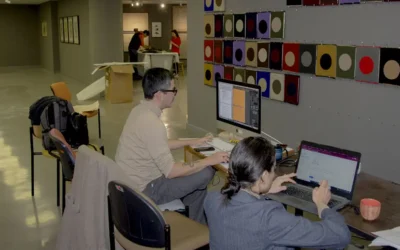Considering Different Options for Delivering a Museum CMS Public Portal

Rachael Cristine Woody
The purpose of a museum online presence is to deliver engaging, educational, and enjoyable content to its audience. Now, with COVID-19, we’ve learned a museum’s online presence may at times be the only way to connect with an audience and deliver value.
The front-end portal to a museum CMS was already considered a major tool to support museum operations, and we’re now realizing (if we hadn’t already) how powerful and important that tool can be—especially when it’s our only tool. With this in mind, we need to consider the different ways a museum CMS front-end is offered, assess whether your front-end portal is working for your museum, and become familiar with the benefits of a fully integrated portal.
Museum CMS Front-end Portal Miniseries
This three-part miniseries will review: 1. The different ways a front-end museum CMS portal is delivered; 2. The cost involved when working with two separate platforms or an “add on” front-end portal; and 3. The benefits of investing in one museum CMS with a fully integrated front and back-end.
The Three Ways a Museum CMS Front-end Can Exist:
As the museum CMS has evolved, so has the way a museum provides external user access to its collections within a CMS. This is otherwise known as the museum front-end, or front-end portal. In the early days of digital museum CMS creation, it was more common to see CMS platforms provide a back-end platform only—forcing museums to either create their own front-end or pay a second vendor to do so. Presently, we more commonly see CMS platforms offer a front-end either as an add on or as an equally invested feature of the whole museum CMS platform.
To summarize, here are the three ways a museum CMS front-end can exist:
- As a completely separate platform from the museum CMS back-end.
- As an “add on” to the existing CMS platform.
- As an equally invested in part of the museum CMS.
1. Two Separate Platforms
Option 1 leaves museum staff on their own to figure out how to provide and maintain a front-end for the museum CMS. The museum will either need a knowledgeable staff member or hire an outside consultant to create the custom code needed to link the front and back-end together. This option requires the investment and maintenance of two separate platforms and increases the workload on staff to push the collections content from one platform (the back-end) to the other (the front-end).
2. As an “Add on” to the Platform
Option 2 is a museum CMS that can provide a front-end portal as an “add on” feature. The optional add doesn’t typically receive the same amount of investment as the back-end which means it’s not nearly as competitive among other CMS front-ends on the market. This option eliminates the need for two platforms, but it fails to provide a tool that can meet staff and user expectations. The museum may save some money and decrease staff labor by moving from two platforms to one, but the quality available for this option will leave a lot to be desired. Staff will have to work extra hard to create customized workarounds in an effort to tweak the front-end into something more acceptable. In the end, this option can cost more money and staff time than having a fully integrated and invested in front-end portal. Which leads us to option number 3…
To learn more about digital user expectations please see my previous posts on Lucidea’s Think Clearly Blog: The Top 4 Things a Museum Needs to Know About the Digital Visitor, and Museum Digital Collections User Types & Expectations
3. A Fully Invested-in and Integrated Front-end Portal as Part of the Museum CMS
Option 3 is a museum CMS that comes with an integrated front-end portal. This portal is fully integrated and has received a substantial amount of investment to make it dynamic, engaging, and visually appealing. While this option can cost more money upfront, it makes up for it by not requiring additional staff labor to support either two separate platforms (option 1) or a platform with a sad front-end portal (option 2).
Conclusion
Seamless integration of a CMS front-end portal is becoming an expected mechanic of any CMS platform. Fully integrated portals offer benefits for the museum, staff, and digital visitors—and should definitely be considered over other options when at all possible.
Additional Reading
If your museum is embarking on a the search for a new museum CMS please check out the following posts on Lucidea’s Think Clearly Blog: 3 Things to Look for When Choosing a Museum Collections Management System, How to Begin Your Search for the Right Museum CMS, How to Form a Museum CMS Procurement Team, How to Test, Vet, and Purchase a New Museum CMS, and How to Identify Specifications for a New CMS. And don’t forget to grab your free e-copy of my book: How to Select, Buy, and Use a Museum CMS.

Rachael Cristine Woody
Expert Rachael Cristine Woody advises on museum strategies, collections management, and grant writing for a wide variety of clients.In addition to several titles published by Lucidea Press, she is a regular contributor to the Think Clearly blog and an always popular presenter. Register here for Rachael’s upcoming webinar, “How to Work with a Consultant on Museum Digital Projects” on September 28, 2022.
Never miss another post. Subscribe today!
Similar Posts
How to Incorporate Interns in Museum CMS Projects: Data Creation
A museum expert details how interns can be successfully included in museum CMS projects at the data creation stage.
How to Incorporate Interns in Museum CMS Projects: Data Capture
A museum expert highlights how interns can be included in museum CMS projects at the data capture stage
How to Incorporate Interns in Museum CMS Projects
A museum expert highlights how interns can be included in museum CMS projects with three project ideas.
Create a Start-to-Finish Process for Cataloging Objects in the Museum CMS
A museum expert outlines the start-to-finish process for cataloging objects into a new museum CMS.
Hosting service
Enjoy all of the benefits of your Lucidea solution with secure, reliable, stress free hosting
Programs & incentives
No matter your size or budget, we’ve got you covered, today and tomorrow




Leave a Comment
Comments are reviewed and must adhere to our comments policy.
0 Comments